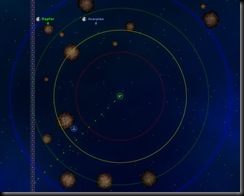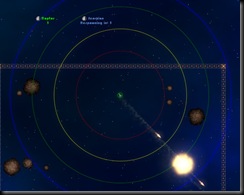As I said in the previous post I was thinking about the best way to automate the gameplay in the game and I decided to go with the artificial intelligence and implemented some logic in order for the ships to move around and shoot and make some sense doing so. Basically, they just wonder around the arena up to a maximum distance from the center (for them not to get stuck in corners) until they get close enough to an enemy ship in which case they initiate the pursuit and try to shoot them. A small trick for them not to just get stuck to each other was to define a minimum distance that they try to maintain from the enemy.
Since the number of options was growing I’ve added an options menu where it’s possible to configure desired resolution, to run or not in full screen, enable/disable bots and others.
Following is a video of the 2 bots as seen by the client (host is the green one) using VFC to reduce the network load. It’s possible to see in the video the varying quantity of data received (in Bytes per Second - shown on the bottom to the left) by the client depending on the distance of the enemy and asteroids. It’s also clear that there the enemy makes some “jumps” when he’s coming from outside the larger circle (which indicate the different consistency zones) due to inconsistency between the opponents’ known position and “real” position.

